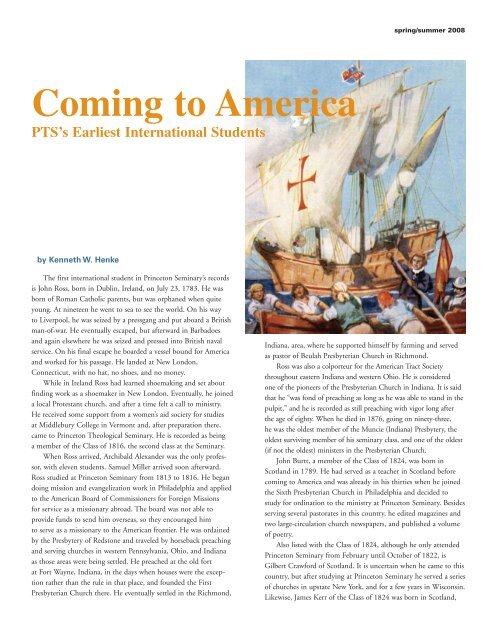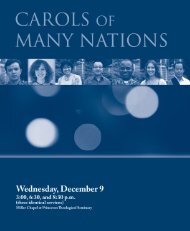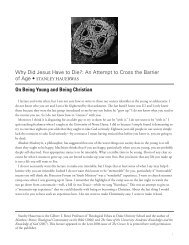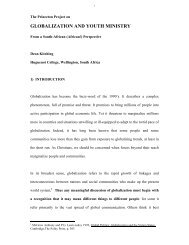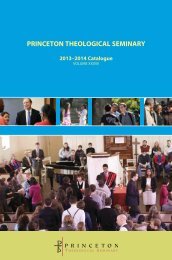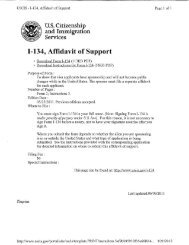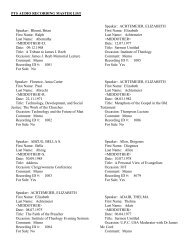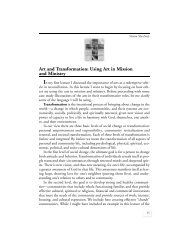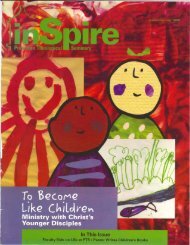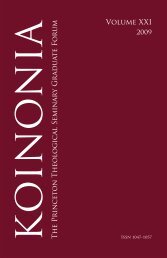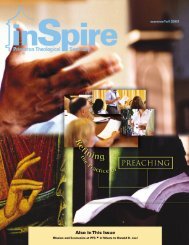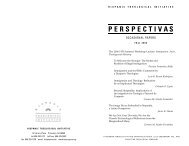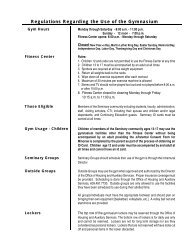Coming to America - Princeton Theological Seminary
Coming to America - Princeton Theological Seminary
Coming to America - Princeton Theological Seminary
You also want an ePaper? Increase the reach of your titles
YUMPU automatically turns print PDFs into web optimized ePapers that Google loves.
spring/summer 2008<strong>Coming</strong> <strong>to</strong> <strong>America</strong>PTS’s Earliest International Studentsby Kenneth W. HenkeThe first international student in Prince<strong>to</strong>n <strong>Seminary</strong>’s recordsis John Ross, born in Dublin, Ireland, on July 23, 1783. He wasborn of Roman Catholic parents, but was orphaned when quiteyoung. At nineteen he went <strong>to</strong> sea <strong>to</strong> see the world. On his way<strong>to</strong> Liverpool, he was seized by a pressgang and put aboard a Britishman-of-war. He eventually escaped, but afterward in Barbadoesand again elsewhere he was seized and pressed in<strong>to</strong> British navalservice. On his final escape he boarded a vessel bound for <strong>America</strong>and worked for his passage. He landed at New London,Connecticut, with no hat, no shoes, and no money.While in Ireland Ross had learned shoemaking and set aboutfinding work as a shoemaker in New London. Eventually, he joineda local Protestant church, and after a time felt a call <strong>to</strong> ministry.He received some support from a women’s aid society for studiesat Middlebury College in Vermont and, after preparation there,came <strong>to</strong> Prince<strong>to</strong>n <strong>Theological</strong> <strong>Seminary</strong>. He is recorded as beinga member of the Class of 1816, the second class at the <strong>Seminary</strong>.When Ross arrived, Archibald Alexander was the only professor,with eleven students. Samuel Miller arrived soon afterward.Ross studied at Prince<strong>to</strong>n <strong>Seminary</strong> from 1813 <strong>to</strong> 1816. He begandoing mission and evangelization work in Philadelphia and applied<strong>to</strong> the <strong>America</strong>n Board of Commissioners for Foreign Missionsfor service as a missionary abroad. The board was not able <strong>to</strong>provide funds <strong>to</strong> send him overseas, so they encouraged him<strong>to</strong> serve as a missionary <strong>to</strong> the <strong>America</strong>n frontier. He was ordainedby the Presbytery of Reds<strong>to</strong>ne and traveled by horseback preachingand serving churches in western Pennsylvania, Ohio, and Indianaas those areas were being settled. He preached at the old fortat Fort Wayne, Indiana, in the days when houses were the exceptionrather than the rule in that place, and founded the FirstPresbyterian Church there. He eventually settled in the Richmond,Indiana, area, where he supported himself by farming and servedas pas<strong>to</strong>r of Beulah Presbyterian Church in Richmond.Ross was also a colporteur for the <strong>America</strong>n Tract Societythroughout eastern Indiana and western Ohio. He is consideredone of the pioneers of the Presbyterian Church in Indiana. It is saidthat he “was fond of preaching as long as he was able <strong>to</strong> stand in thepulpit,” and he is recorded as still preaching with vigor long afterthe age of eighty. When he died in 1876, going on ninety-three,he was the oldest member of the Muncie (Indiana) Presbytery, theoldest surviving member of his seminary class, and one of the oldest(if not the oldest) ministers in the Presbyterian Church.John Burtt, a member of the Class of 1824, was born inScotland in 1789. He had served as a teacher in Scotland beforecoming <strong>to</strong> <strong>America</strong> and was already in his thirties when he joinedthe Sixth Presbyterian Church in Philadelphia and decided <strong>to</strong>study for ordination <strong>to</strong> the ministry at Prince<strong>to</strong>n <strong>Seminary</strong>. Besidesserving several pas<strong>to</strong>rates in this country, he edited magazines andtwo large-circulation church newspapers, and published a volumeof poetry.Also listed with the Class of 1824, although he only attendedPrince<strong>to</strong>n <strong>Seminary</strong> from February until Oc<strong>to</strong>ber of 1822, isGilbert Crawford of Scotland. It is uncertain when he came <strong>to</strong> thiscountry, but after studying at Prince<strong>to</strong>n <strong>Seminary</strong> he served a seriesof churches in upstate New York, and for a few years in Wisconsin.Likewise, James Kerr of the Class of 1824 was born in Scotland,
spring/summer 2008attended Prince<strong>to</strong>n <strong>Seminary</strong> from 1821 <strong>to</strong> 1823, and spent therest of his ministerial career as a missionary in the <strong>America</strong>n South,especially rural Virginia and North Carolina.Another Class of 1824 member from abroad was JohnMitchelmore, born in England in 1793. He came <strong>to</strong> <strong>America</strong> in1816 when he was twenty-three, joined a Presbyterian church, andby 1819 felt a call <strong>to</strong> the ministry. The presbytery arranged for him<strong>to</strong> do prepara<strong>to</strong>ry studies at the classical academy in Lawrenceville,from which he graduated in 1822. He then came <strong>to</strong> study atPrince<strong>to</strong>n <strong>Seminary</strong> and after graduation served several unitedchurches in rural Delaware until his untimely death in 1834, whenhe perished in the burning of the steamboat William Penn, onwhich he was a passenger traveling <strong>to</strong> Philadelphia. It is recordedthat he died while trying <strong>to</strong> calm and assist his terror-strickenfellow passengers. Among his last acts was <strong>to</strong> take off the largecloak he was wearing, wrap it around a little child, and throw itashore, where the child was saved. When he could do no more onthe ship and the heat had become unbearable, he jumped from theburning deck in<strong>to</strong> the cold waters of the river and swam for shore.However, the shock from the extremes of heat on the burning deck<strong>to</strong> the chill of the water was <strong>to</strong>o much, and though he was able <strong>to</strong>reach the shore, he perished before anyone could come <strong>to</strong> his aid.Each of these students, though born and raised abroad, chose<strong>to</strong> stay and follow their pas<strong>to</strong>ral vocation in the young <strong>America</strong>.It should be remembered that at this time the areas from which theycame—England, Scotland, and Ireland—were the “old country,” andit was <strong>America</strong>, particularly rural <strong>America</strong> and the <strong>America</strong>n frontier,that was one of the important mission fields of the day. Even <strong>to</strong>daysome of our international students stay <strong>to</strong> work in this country, especiallyamong the immigrant groups and first- and second-generation<strong>America</strong>ns from the countries of their own origins.The first student from overseas <strong>to</strong> come <strong>to</strong> Prince<strong>to</strong>n<strong>Theological</strong> <strong>Seminary</strong> who did not have English as a first languagewas likely David Christian Bernard Jadownicky (as his name readsin the records of the First—now Nassau—Presbyterian Churchof Prince<strong>to</strong>n.) The “David Christian” part of this name was likelya later addition, taken at the time of his baptism, for the earlycatalog records of the <strong>Seminary</strong> simply read “Bernard Jadownicky,”and a published letter by him in Ashbel Green’s Christian Advocatefrom June 1823 is simply signed “B. Jadownicky.”This unlikely Prince<strong>to</strong>n <strong>Theological</strong> <strong>Seminary</strong> student was bornin<strong>to</strong> a Jewish family in Poland in 1799. At thirteen he was sent <strong>to</strong>a Jewish Talmudical School in Berlin <strong>to</strong> study <strong>to</strong> become a rabbi.In Berlin Jadownicky learned <strong>to</strong> write and speak fluent German,and after graduating in 1818 served as a rabbi in the German <strong>to</strong>wnof Solingen, famous <strong>to</strong> this day for its manufacture of swords, knives,and cutlery. After a few years he came across a copy of a HebrewNew Testament that had been lately published in London.Jadownicky found this reading compelling, and this led <strong>to</strong> hisfurther reading of Hebrew language tracts and pamphlets designed<strong>to</strong> explain Christian beliefs <strong>to</strong> Jews. Finding himself religiouslyperplexed, he went <strong>to</strong> speak with a Jewish convert who was nowa Protestant minister in Frankfort. The result of the conversationsand instruction he received was his own conversion and baptismin<strong>to</strong> the Christian faith in April 1821. Taking the advice of someof his new Christian friends, he decided <strong>to</strong> pursue Christiantheological studies and prepare himself as a Christian missionary<strong>to</strong> the Jewish people. On his way <strong>to</strong> Berlin <strong>to</strong> take up these newstudies he met a pious German nobleman, Adelberdt, Count vonder Recke, who had set up a settlement for converted Jews (whoafter their conversion usually lost their previous means of makinga living in the Jewish communities in which they had lived) ona forty-acre farm near Dusseldorf. The Count asked Jadownicky<strong>to</strong> spend some time at his residence and help with the project.About this time the Count became aware of the <strong>America</strong>nSociety for Meliorating the Condition of the Jews in New York,which had a similar idea for setting up a colony for Christian Jewsin North <strong>America</strong>. They envisioned the Count’s farm as a stagingground for sending converted European Jews on <strong>to</strong> their projectedlarger community, which they hoped <strong>to</strong> establish somewhere inupstate New York. The Count asked Jadownicky <strong>to</strong> go as his agentand give further particulars about the situation in Europe <strong>to</strong> ameeting of the North <strong>America</strong>n group. The group was favorablyimpressed with Jadownicky, asked him <strong>to</strong> work with them, andarranged for him <strong>to</strong> continue his studies in Prince<strong>to</strong>n.Since Greek and Latin were not part of the usual rabbinictraining, Jadownicky first <strong>to</strong>ok the necessary language classes atPrince<strong>to</strong>n University (known in those days as the College of NewJersey) before proceeding <strong>to</strong> theological studies at the <strong>Seminary</strong>from 1823 until 1825. It would appear that he lived, at least forsome time, in the home of Charles Hodge. In a letter written inDecember 1822, Hodge writes: “I am studying German again:having a teacher in the house I hope <strong>to</strong> make more progress thanI did before. We find Mr. Jadownisky [sic—the ‘c’ in Jadownicky ispronounced soft, as an ‘s’, so it would be natural for Hodge <strong>to</strong> spellit this way] a pleasant and intelligent young man.” In December1823, he joined the First Presbyterian Church in Prince<strong>to</strong>n.Jadownicky continued his studies and his work with the<strong>America</strong>n Society for Meliorating the Condition of the Jews forseveral years, but appears <strong>to</strong> have left that work around 1826. Afurther mention is made of him in the Life of John Kit<strong>to</strong> compiledafter Kit<strong>to</strong>’s death by the noted Glasgow Presbyterian leader andscholar John Eadie. Kit<strong>to</strong> had lost his hearing at age twelve, afterfalling from a ladder, but by his early twenties felt called <strong>to</strong> fulltimeChristian service. Since his deafness would be a hindrance<strong>to</strong> his becoming an evangelist, he was trained as a printer andsent by the British Church Missionary Society <strong>to</strong> Malta, wherethey had printing presses turning out books and tracts in Greek,Arabic, Maltese, and Italian for circulation throughout the easternMediterranean. In connection with his deafness, Kit<strong>to</strong> had developeda growing reluctance <strong>to</strong> speak, and carried around pencil andpaper <strong>to</strong> conduct his conversations with others by writing. Notusing his vocal organs nearly led <strong>to</strong> the inability <strong>to</strong> use them al<strong>to</strong>gether.It was on the voyage <strong>to</strong> Malta in early summer 1827 thatKit<strong>to</strong> met Jadownicky (who was perhaps on his way <strong>to</strong> Palestine)and who, <strong>to</strong>gether with another traveling companion, did hima singular favor that was <strong>to</strong> make a major difference for the res<strong>to</strong>f his life. Kit<strong>to</strong> tells the s<strong>to</strong>ry as follows:
spring/summer 2008“When I first went <strong>to</strong> the Mediterranean, the companions ofmy outward voyage were Dr. Korch, a German physician, who hadlately taken orders in the Anglican church, and Mr. Jadownicky,a converted Polish Jew, lately arrived from <strong>America</strong>, where he hadbeen completing his Christian education. These well-informed andkind-hearted men, being always with me, soon perceived how thematter really s<strong>to</strong>od; and after much reasoning with me on thematter, they entered in<strong>to</strong> a conspiracy in which the captain of theship joined, not <strong>to</strong> understand a word I said, otherwise than orally,throughout the voyage. In this they persevered <strong>to</strong> a marvel; and asI had much <strong>to</strong> ask, since I had not before been at sea, I made verygreat progress with my <strong>to</strong>ngue during the six weeks’ voyage, and,by the time we reached our destination, had almost overcome thehabit of clutching a pen or pencil, <strong>to</strong> answer every question thatwas asked me.”This proved <strong>to</strong> be an important turning point for Kit<strong>to</strong>.He began using his voice more, first with close friends, then withacquaintances, and finally even with strangers. Later in life he wasable <strong>to</strong> write that “under the improvement which practice gave, myvoice was so much bettered, that the instances in which it was notreadily unders<strong>to</strong>od, gradually diminished; and, at the present day,I rarely find even a foreigner <strong>to</strong> whom my language is not clear.”Kit<strong>to</strong> also relates how on the voyage <strong>to</strong> Malta he wished one night<strong>to</strong> sleep out under the stars and awake <strong>to</strong> view the sunrise, and howJadownicky had loaned him his “thick cloak” <strong>to</strong> use as beddingon the deck.Kit<strong>to</strong> went on <strong>to</strong> travel extensively in Bible lands, and returnedhome <strong>to</strong> England <strong>to</strong> write accounts of his travels. Eventuallyhe brought his knowledge of the Near East and its peoples andcus<strong>to</strong>ms <strong>to</strong> bear in helping bring the Bible <strong>to</strong> life for lay readersin a series of lavishly illustrated, multi-volume aids for biblicalstudy. These included a four-volume pic<strong>to</strong>rial Bible, giving thefull text of the Bible, illustrated with steel engravings and hundredsof woodcuts representing landscape scenes, natural his<strong>to</strong>ry,costumes, and archaeological finds, <strong>to</strong>gether with explana<strong>to</strong>rynotes throughout giving his<strong>to</strong>rical and geographic background,describing in greater detail the plants and animals mentionedin the text, and providing literary and other illustrative materials.He also produced an illustrated Encyclopedia of Biblical Literatureand an eight-volume guide through the entire Bible giving suggestedtexts and informative background readings, one for each dayof the year, called Daily Bible Illustrations. These eight volumeswere especially designed for personal study or for reading aloudin the family, and the noted Baptist preacher Charles Spurgeonsaid of them that they were “more interesting than any novel thatwas ever written and as instructive as the heaviest theology.”After the Malta voyage with Kit<strong>to</strong>, we have little recordof Jadownicky and his travels. However a few years beforeJadownicky’s death at age sixty-three, Archibald Alexander Hodgementioned <strong>to</strong> an inquiring colleague that he had a “rather shakypersonal recollection” from his childhood of his father speakingof a Jewish student named “Jadownisky” who had studied at the<strong>Seminary</strong> in 1823–1824, about the time of his own birth, and thathe thought he remembered sometime when he was a teenager thatJadownicky had returned <strong>to</strong> Prince<strong>to</strong>n <strong>Seminary</strong> for a visit andworshipped with the Hodge family in their pew at Miller Chapel.His memory was that Jadownicky had mentioned <strong>to</strong> CharlesHodge at that time that he was supporting himself by engagingin trade, especially in the West Indies and Cuba, but that he hadnever abandoned his Christian profession. A further note in PTSrecords suggests that Jadownicky may have returned <strong>to</strong> his nativePoland sometime before his death, which is recorded there asprobably about 1853.A final s<strong>to</strong>ry worth telling here is the s<strong>to</strong>ry of Guy Chew,a Native <strong>America</strong>n of the Mohawk tribe. Converted <strong>to</strong>Christianity at age eighteen, he attended the Mission Schoolat Cornwall, Connecticut. This school had been set up by theCongregationalists with the help of a young Hawaiian, HenryObookiah, who had been brought <strong>to</strong> <strong>America</strong> at his own requestby a sea captain and was studying <strong>to</strong> be a missionary back <strong>to</strong> hisown people when he contracted typhus fever and died in early1818. Shortly after his death a book appeared in which Henrytells in his own words the s<strong>to</strong>ry of his life and <strong>to</strong> which othersFrom 1817–1826 this school trained nearly 100 students from China, India,Hawaii and Polynesia, Malaysia, and several Native <strong>America</strong>n tribes.added a few particulars, including an account of his death. His pleafor a mission <strong>to</strong> his people inspired the beginnings of Christianmissions <strong>to</strong> Hawaii in which a number of our own early Prince<strong>to</strong>n<strong>Theological</strong> <strong>Seminary</strong> graduates would participate. Also attendingthis school were Native <strong>America</strong>ns who wished <strong>to</strong> spread the gospelamong their people. Guy Chew studied at this school for threeyears “and became eminent for his benevolence, piety, and desire<strong>to</strong> proclaim the gospel <strong>to</strong> his countrymen.” He came <strong>to</strong> Prince<strong>to</strong>n<strong>Seminary</strong> in 1826, but as his graves<strong>to</strong>ne (which may still be seen inPrince<strong>to</strong>n Cemetery) reads, he that same year “was by a MysteriousProvidence called away in the morning of his days,” the first Native<strong>America</strong>n <strong>to</strong> attend Prince<strong>to</strong>n <strong>Theological</strong> <strong>Seminary</strong>. ❚Kenneth W. Henke is the <strong>Seminary</strong>’s reference archivist.


